FAQs Every Homeowner Asks About Gutters (and What We Recommend)
Your gutters might not get much attention, but they are one of the most important systems protecting your home. Every year, they quietly direct thousands of gallons of rainwater away from your roof, siding, and foundation. When they fail, though, the results can be costly.
At Empire, we often hear the same questions from homeowners who notice a gutter issue but aren’t sure how serious it is, or what to do next. To help you make informed decisions and protect your home, we are answering the most common gutter repair and replacement questions.

1. “Do I need all new gutters, or can you just patch what’s broken?”
That is usually the first question homeowners ask. Sometimes, a small, localized repair is enough. But in many cases, what looks like a minor problem signals a larger issue beneath the surface.
Patrick Oliverio, Co-Founder of Empire Contractors, shares his perspective:
“I always aim for a long-term solution. I once saw a situation where a quick patch job wasn’t enough, and it ended up causing the gutters and fascia board to detach from the house. The homeowner ended up facing much higher repair costs down the line.”
Our Recommendation:
If your gutters are older, have multiple damaged sections, or the fascia board behind them is soft or rotting, a full replacement is typically the smarter long-term choice. We will always give you an honest assessment of whether a repair or replacement will better protect your home.
2. “What happens if I don’t fix damaged gutters right away?”
It is easy to ignore a small sag or leak. But over time, water always finds weak spots and seeps into hidden areas, leading to worse and more expensive damage.
Josh Weber, Empire’s Production Manager, shares a real example:
“By the time the homeowner called, water had gotten behind the fascia board and soffit, soaked through the insulation, and everything was rotten.”
Our Recommendation:
Even small gutter issues can lead to wood rot, saturated insulation, mold, and interior wall damage. Address problems early to prevent structural deterioration and costly repairs down the road.
3. “How can I tell if my gutters are causing interior or structural damage?”
Not all gutter problems are visible from the outside. Look for signs that water is escaping where it shouldn’t:
- Water stains or mildew on your siding
- Peeling paint on fascia boards
- Water dripping from soffits or pooling near your foundation
- Soil erosion around the base of your home
Our Recommendation:
If you notice any of these signs, schedule a professional inspection. Our team can identify where water is getting in and recommend the right fix before the damage spreads.
4. “Do you handle gutter-only projects, or only with roof replacements?”
Many people think we only replace gutters when we’re doing a roof, but that’s not the case. We offer gutter-only services for homeowners who simply need an upgrade.
One of our team members often hears:
“I didn’t even know you guys did gutters!”
Our Recommendation:
Whether your roof is new or your gutters are just outdated, we provide seamless gutter systems that are custom-fit to your home for a clean look and optimal water flow. You don’t have to wait for a new roof to get new gutters.
5. “Do you offer different types of gutter options or upgrades?”
Absolutely. Every home is different, so we offer a range of materials and systems to match your home’s design and performance needs.
Here’s how we guide homeowners through their options:
- Materials: From durable aluminum to premium copper systems.
- Sizes: To handle the amount of rainfall typical in our Cincinnati region.
- Gutter Guards: A smart upgrade that keeps debris out and maintenance low.
Our Recommendation:
During your consultation, we’ll walk you through each option and help you choose what makes the most sense for your home and budget, without pressure.
Don’t Let a Small Gutter Problem Become a Big Headache
Your gutters are an important part of keeping your home safe from water damage. If you’re noticing signs of wear or aren’t sure what to do next, it’s a good idea to get a professional opinion.
At Empire Contractors, we offer free, no-obligation gutter inspections to help you understand your options. Our team will assess the condition of your gutters and provide recommendations, so you can make an informed decision to protect your home.
Why Gutter Maintenance Matters: A Westside Cincinnati Homeowner’s Wake-Up Call
Gutters often get overlooked until it’s too late. On the Westside of Cincinnati, one homeowner discovered just how important proper gutter maintenance really is when a routine cleaning turned into a much bigger issue. Here’s the story of how a simple gutter cleaning job turned into a lesson about how neglecting gutters can cause real damage to your home, and how you can avoid the same mistakes.
A Simple Gutter Cleaning Job Turns Into a Big Problem

When a homeowner on the Westside called us at Empire Contractors to clean out their gutters, we expected it to be a typical job. Leaves, twigs, debris, basically the usual suspects. But once our technician got up there to inspect the gutters, it quickly became clear that this wasn’t just a simple cleaning.
“The gutters were sagging and pulling away from the house. The fascia board had started peeling off, and water had been collecting in places it shouldn’t,” our technician explained. “It was obvious that the gutters weren’t functioning properly, and it wasn’t just about cleaning out some debris anymore. This was a gutter maintenance issue that hadn’t been addressed.”
Finding Hidden Damage
As the technician took a closer look, the issue was much bigger than anticipated. The water was pooling and spilling over the edges because the home was missing a crucial component: a gutter apron.
What’s a gutter apron? It’s a piece of metal flashing that runs along the roof’s edge, helping to direct rainwater into the gutters and away from the roofline. Without it, the water doesn’t flow properly and ends up spilling over, causing damage to the home’s fascia, soffit, and foundation.
“Without that simple component, water was getting into places it shouldn’t have,” our technician said. “It was just a small piece missing, but it was enough to cause significant damage. This is why regular gutter maintenance is key to preventing such issues.”
Replacing Gutters and Adding the Gutter Apron
Once we understood the full scope of the issue, it was clear that a simple cleaning wouldn’t cut it. The gutters were old and in poor shape, so the best solution was to replace them entirely. And when it came to the new installation, adding a gutter apron was non-negotiable.
“We replaced the gutters with new ones and made sure to install a gutter apron,” our technician said. “That little piece ensures water flows directly into the gutter, keeping everything in place and preventing damage to the roof and fascia. This is exactly the kind of fix that gutter maintenance is all about.”
By making these repairs, the homeowner’s gutters were not only cleaned but also fully upgraded to handle whatever Cincinnati’s weather throws at them.
Why Gutter Maintenance Is So Important in Cincinnati
Cincinnati’s weather is tough on homes. With heavy rains, freezing temperatures in the winter, and fluctuating seasons, your gutters are constantly exposed to the elements. If gutters aren’t properly maintained, they can quickly go from a helpful system to a cause of significant damage. Clogged, sagging gutters, or missing components like the gutter apron, can lead to everything from water damage to mold growth and foundation issues.
Maintaining your gutters doesn’t have to be complicated. Here’s how you can keep them working properly and avoid problems like the one this homeowner faced:
- Schedule Regular Inspections
If you’re unsure about the condition of your gutters, schedule a professional inspection. It’s a small investment that can help you avoid costly repairs and ensure your gutters are ready for the next storm. - Clean Your Gutters Regularly
Clean your gutters at least twice a year—once in the spring and once in the fall. If you have many trees nearby or experience heavy storms, more frequent cleaning may be necessary to prevent blockages. - Install Gutter Guards
Gutter guards help prevent debris from accumulating in your gutters, making cleaning easier and reducing the risk of clogs. While they don’t eliminate the need for cleaning altogether, they can reduce the frequency of maintenance. - Check for Damage
Inspect your gutters regularly for cracks, holes, or signs of sagging. Catching and repairing small issues early can save you from much bigger problems later on. - Trim Overhanging Trees and Shrubs
Trees and shrubs can drop leaves and debris into your gutters, which can lead to clogs. Regularly trim branches that hang over your gutters to minimize the amount of debris that falls in.

Protect Your Home by Maintaining Your Gutters
This homeowner learned firsthand how quickly a small gutter issue can turn into a major problem. By replacing the gutters, adding a gutter apron, and keeping up with maintenance, they were able to protect their home from future damage.
Taking the time to focus on gutter maintenance can save you from costly repairs later. If you need help with your gutters, don’t hesitate to get in touch for a quick inspection.
How Much Does Roof Repair Cost in Cincinnati? 2025 Price Guide
Roof repairs are one of those home improvement tasks that often come at inconvenient times, but knowing what affects cost—and what you should expect—can help you budget, avoid surprises, and work with trustworthy roofing contractors. If you live in Cincinnati or the region, here’s a detailed breakdown for 2025, including what influences pricing, typical price ranges, and tips for getting quality roofing services with peace of mind.
What “Roof Repair” Means

Before diving into pricing, let’s be clear: “roof repair” can cover a lot of ground. It might mean:
- Fixing isolated damage (e.g. missing or damaged shingles)
- Repairing flashing, vents, gutters, or chimney connections
- Addressing leaks / water intrusion issues
- Replacing small sections of roof decking or underlayment due to rot or storm damage
- Corrections of installation errors or problems caused by aging components
Because of that variation, cost ranges are wide. What follows are the main factors that influence cost in Cincinnati, and then typical price ranges for different repair types.
Key Factors Affecting Roof Repair Costs in Cincinnati
Here are the major variables that roofing contractors will consider when estimating your repair job, and which you should ask about.
| Factor | How It Affects Cost | What to Ask / Consider |
|---|---|---|
| Size and accessibility | Larger areas or steep/sloped/complex roofs take more labor/time to repair and may require special safety equipment. More difficult access (e.g. tall rooflines, multiple levels) raises labor cost. | Ask how many “square feet” or “squares” the repair area is. Does the contractor charge extra for height or difficult access? |
| Type & quality of roofing materials | Asphalt shingles cost much less; metal panels, specialty shingles, tiles, slate cost more. If materials must match existing roof, you may have limited supply. Quality of underlayment, flashing, fasteners matters. | What shingles or roofing materials do they match to? Are they using high-grade materials or “builder-grade”? What warranty do the materials carry? |
| Extent of damage | A simple leak fixed by replacing a few shingles is inexpensive. But water damage can extend under multiple layers or into the decking/structure, increasing cost sharply. | Does the damage reach beyond the surface? Is there rot, mold, or structural damage? How much tear-off or removal is required? |
| Labor costs and complexity | More experienced teams cost more, but often deliver better workmanship. Steep roofs, complex rooflines, penetrations (vents, skylights, chimneys), valleys, etc., complicate work. | Ask about the contractor’s experience. Do they have an experienced team? What complexity features does your roof have? |
| Permitting, code compliance, disposal | Some repair tasks require permits; removing old material costs disposal fees. Local building codes must be met, which can add cost. | Will the estimate include permit fees? How do they handle debris cleanup/disposal? |
| Tariffs / material supply chain / inflation | 2025 has seen rising costs for roofing materials due to tariffs on steel, aluminum, and components; supply chain disruptions; labor shortages; and inflation. All this can increase both material and labor expenses. | Ask whether material prices are locked in or subject to change, how long the lead-time is for materials, whether they use domestic vs imported components. |
| Residential vs commercial roofing | Commercial roof systems (flat roofs, membranes, metal systems) have different materials, larger scale, more penetrations, possibly more regulation. Commercial repairs often cost more per square foot because of these complexities. | If you own or manage a commercial building, check the contractor’s experience with commercial roof systems. What warranties / service agreements are offered? |
Typical Roof Repair Cost Ranges in Cincinnati (2025)
Below are ballpark figures for common roof repair tasks in Cincinnati, taking into account the factors above. These are estimates—your actual cost may be higher or lower depending on your specific situation. All prices assume residential roofing unless noted.
| Repair Type / Scenario | Typical Cost Range* | What Drives the Cost Up in That Scenario |
|---|---|---|
| Minor repair (replace a few asphalt shingles, fix flashing, seal small leaks) | $200 – $800 | Quality of flashing, extent of damage, roof get-atability, matching existing shingles. |
| Moderate repair (replace underlayment in small section, fix multiple leaks, siding/trim or flashings around chimneys or skylights) | $800 – $2,500 | If there is slight structural damage, if roof is steep, or roofline is complex. |
| Extensive repair (large section replacement, structural / decking / rot repair, roof deck replacement, large leak damage) | $2,500 – $5,000+ | Extent of rot/wood damage, whether full tear-off is needed, sourcing matching materials, labor access. |
| Commercial roof repair / flat roof repair | Varies widely, often $5,000 – $20,000+ depending on system area, membrane type, structural issues, slope, number of penetrations | Materials for commercial membranes, drain/flashings, insulation, safety requirements, possible code permits. |
*These are rough 2025 estimates for Greater Cincinnati. They assume an experienced team, good customer service, and quality roofing materials. Minor jobs may be lower; complex or rush jobs may cost more.
What About Roof Replacement vs Repair?
Sometimes what you think is a repair ends up being close to a replacement—especially with older roofs, repeated leaks, or where materials are failing in multiple spots. For context:
- Roof replacement in Cincinnati for a typical size (1,600–1,800 sq ft) with asphalt roofing can cost in the ballpark of $10,000 to $16,000+.
- If you’re seeing recurring repair issues, it may be more cost-effective in the long term to replace. A good roofing company will help you evaluate repair vs replacement.
Effect of Tariffs & Material Price Trends in 2025

Because so many roofing repairs use metal components (flashings, fasteners, metal panels), here’s how tariffs and supply pressures are impacting costs:
- New tariffs in 2025 on steel and aluminum have increased the cost of metal roofing panels, flashing, and fasteners. Some tariffs have risen from 25% to as high as 50% for certain steel/aluminum goods.
- Imported roofing materials or components (e.g. specialist flashing, membranes, coatings) are more expensive due to higher import taxes, shipping delays, or supply chain bottlenecks.
- Domestic production helps, but demand is high and raw materials costs are up (lumber, asphalt, polymers, metal) which feed into roofing material pricing.
Because of these, contractors may include price escalation clauses, or require that you order materials in advance. Availability can also affect time‐to‐finish, which in turn can affect labor costs (overtime, scheduling).
What You Should Expect from a Good Roofing Company
To ensure your roofing project is handled well, here’s what you want in a contractor. These are traits that help avoid overpayment, low quality, and post-repair headaches.
- Experienced team: Roofers with solid experience in both repair and installation. They understand local Cincinnati roofing conditions (snow load, freeze/thaw cycles, storms).
- Quality roofing materials: Not just cheap, but durable materials—good flashing, quality underlayment, proper fasteners, warranties.
- Clear, written estimate: Includes labor vs materials, what is being repaired vs replaced; free no‐obligation estimates are very helpful.
- Minimal disruption: Good contractors plan so disruption to your home is minimized—protection, cleanup, scheduling.
- Strong customer service & after-work follow up: You’ll want a roofing company that stands behind repairs, addresses leaks or issues that emerge after repair, and communicates well.
- Certifications / licensing / insurance: Ensures you’re protected from liability, and that repairs meet local building codes.
Tips to Keep Roof Repair Costs More Manageable
Here are practical ways homeowners in Cincinnati can keep repair costs reasonable:
- Catch issues early: Small leaks and damaged shingles cost far less to fix than letting damage spread to decking or structure.
- Regular maintenance: Keeping gutters clean; trimming trees; inspecting after storms. Preventing damage reduces large repairs.
- Choose local materials / suppliers when possible: Shipping and import costs add up. Domestic suppliers may offer more stable prices.
- Shop around but check reviews: Get quotes from 2–3 roofing contractors; compare not just price, but what’s included, quality of roofing materials, warranties. Use local reputations.
- Ask about warranties and guarantees: Sometimes paying a bit more now for good materials and workmanship saves more in future.
Sample Breakdown: What a Typical Repair Might Cost (Realistic Scenario)
Here’s a hypothetical example to illustrate:
| Scenario | What Needs Doing | Estimated Cost |
|---|---|---|
| Single leak around chimney flashing, some damaged shingles, minor underlayment repairs, no structural damage, easy access | Roofing contractor comes, removes old flashing, installs new flashing, replaces maybe 10‐15 shingles, seals area, cleans up | $600 – $1,200 depending on material match, whether specialty flashing, and warranty provided |
| After a windstorm: several missing shingles, damaged fascia or soffit trim, minor water staining underneath, requires some underlayment and deck inspection | More shingles replaced, trim work, possibly small decking replacement, install new underlayment, ensure good sealing | $1,500 – $3,500 depending on size of damage area and steepness of roof |
| Flat roof section (commercial/residential) with membrane damage, ponding water, leaks at penetrations | Remove damaged membrane, repair or replace insulation, reseal or replace flashings around drains/vents, ensure slope for drainage | $2,500 – $7,500+ depending on area, membrane type, and how extensive damage is |
What Does Roof Repair Cost in Cincinnati in 2025: Price Guide Summary
Here’s a quick reference summary for Cincinnati:
- Minor repairs: $200 – $800
- Moderate repairs: $800 – $2,500
- Large or complex residential repairs: $2,500 – $5,000+
- Commercial or flat roof systems, or repair involving structural damage: $5,000 – $20,000+
If you’re also considering roof replacements, expect residential full roof replacements around $10,000 to $16,000+ for a standard home (depending on roof size, materials, etc.) in Cincinnati.
Why Working with Empire Contractors Gives You Peace of Mind
Here’s how Empire Contractors does things to help keep your roof repair cost reasonable and ensures quality:
- We’re an experienced team with years of doing residential and commercial roofing projects in Cincinnati and the surrounding region.
- We offer free no-obligation estimates, so you can get a clear idea of costs before anything is committed.
- We focus on quality roofing materials, proper flashings, underlayment, and detailing, not cutting corners.
- We aim for minimal disruption, protecting your home or business during repair, cleaning up thoroughly, staying on schedule.
- Our customer service does not end when the job is done—we stand behind our work, address issues if they arise, and aim to be a roofing company you’d highly recommend.
Roof repair cost in Cincinnati in 2025 will vary a lot depending on size, material, extent of damage, how accessible the roof is, and how the broader material market (tariffs, supply) is behaving. But if you know the ranges above, and you partner with an experienced roofing company that provides transparency, good service, and quality materials, you can go into your roofing project prepared and confident.
What Sets a Great Cincinnati Siding Company Apart from the Rest?
When you’re undertaking a home improvement project in Cincinnati, choosing the right siding company is crucial. Siding isn’t just about curb appeal—it protects your home, impacts energy efficiency, and if done wrong, can lead to costly repairs. Below are what truly set great siding companies apart from the rest, drawing on what Empire Contractors and others in the area do well.
Key Qualities of Outstanding Cincinnati Siding Companies

Here are the main traits and practices that distinguish top-tier siding companies. If your contractor has most or all of these, you’re likely in good hands.
| Trait | Why It Matters | What to Look For / Questions to Ask |
|---|---|---|
| Years of experience | Experience often means they’ve seen many siding scenarios: different weather, material failures, tricky geometries. This helps avoid rookie mistakes. | Ask how long they’ve been doing siding. Do they specialize in siding and roofing, or are they general contractors? For example, Mr. Roof in Cincinnati emphasizes they have over 60 years of experience. |
| High quality materials & options | The longevity and maintenance of siding depend heavily on the material—vinyl, fiber cement, wood or cedar, composite, etc. The right options give both performance and aesthetics. | Look for contractors that offer multiple siding options: cedar siding, James Hardie (fiber cement), vinyl siding, etc. Do they explain trade-offs (cost, durability, maintenance)? |
| Durable, low-maintenance solutions | Homeowners want siding that stands up to Cincinnati’s weather, needs minimal upkeep, and gives peace of mind. | Ask about warranties, resistance to moisture, pests, rot. Does the contractor install siding that won’t warp, fade, or buckle? Mr. Roof notes its siding is “virtually maintenance-free.” |
| Attention to detail in siding installation | Even high-end materials won’t perform if installation is sloppy (gaps, improper flashing, poor sealing, etc.). | Inspect past work or portfolio. Do they do inspection, careful prep, alignment, sealing, trim work, etc.? |
| Customer service & communication | Projects often reveal surprises—good contractors manage expectations, keep homeowners informed, and follow through on promises. | Are they responsive? Do they provide free estimates? Do they walk you through siding options, installation steps, warranties, after-care? Do reviews mention friendly, professional, clear communication? Superior Products Exteriors, for example, highlight “fast, friendly service” and treating both small and large jobs with respect. |
| Transparent, free no-obligation estimates | Before you commit, you need a clear picture of cost, materials & timeline—with no hidden surprises. | Does the company offer free no obligation estimate(s)? Do they itemize materials vs labor? Any surprises in what is or isn’t included? Titan Siding & Roofing offers free inspections & estimates. |
| Strong warranty / guarantee | Materials or workmanship can fail. A good siding contractor backs their work so you have protection. | Ask about warranties on materials (e.g. from the siding manufacturer like James Hardie) and workmanship. How long is the guarantee? What maintenance is required to keep that warranty? |
| Solid roofing experience (if they also handle roofing) | Because siding and roofing often interact (e.g. flashing, water run-off, roof overhangs), it’s a plus if the contractor also has roofing expertise—helps avoid leaks or other exterior failures. | If your siding company also does roofing, check their roofing portfolio. Empire Contractors does roofing, siding, windows and gutters, which gives them more comprehensive exterior experience. |
| Local reputation & references | Local experience means they understand local codes, climate (humidity, snow, wind), and local challenges. References help you verify consistency. | Check reviews, examples of past siding installations in your neighborhood(s). Are people saying “stands the test of time”? How do they handle problems when they arise? |
How Empire Contractors Measures Up

Empire Contractors already ticks many of these boxes. Here are some of their strengths, as well as areas where homeowners should ask good questions, to ensure they get the great service they deserve.
Strengths:
- Offers both roofing and siding services, plus windows and gutters, which means they have integrated exterior experience.
- They work with a variety of siding products: vinyl, fiber cement (which can include brands like James Hardie), custom siding options.
- Provides free quotes (“Get Your FREE Quote”) and honest transparent pricing. Empire’s process includes a free inspection.
Questions to Ask / Areas to Confirm:
- What are the warranties (material + workmanship) and how do they compare among siding options?
- How do they handle moisture, flashing, trim details, which are often the weak spots in siding installation?
- What customer service follow-up is provided after installation—is there cleanup, walkthrough, adjustments if needed?
- What maintenance is required for the materials you choose, especially if selecting cedar siding or composite vs vinyl?
Siding Material Options: Pros & Trade-Offs
Choosing the right siding material is a core part of what sets one company apart. Here’s a quick comparison of popular siding options, especially those used by Cincinnati contractors.
| Material | Pros | Trade-Offs |
|---|---|---|
| Vinyl siding | Durable, low maintenance, cost-effective, wide range of colors & styles, good withstanding of moisture & insects. Mr. Roof highlights it as popular and virtually maintenance-free. | Can fade over time, may crack (in extreme cold or hail), less premium look than wood or fiber cement; trim and flashing details still matter. |
| Fiber cement (James Hardie etc.) | Very durable, fire-resistant, more premium look, good withstanding of rot & moisture, long lifespan. | Heavier, more expensive materials & installation; needs proper sealing & painting; more labor intensive; higher upfront cost. |
| Cedar / wood siding | Beautiful natural aesthetics; classic, high-end appearance; good insulation; if maintained well, can last long. | Requires more maintenance (staining, sealing), more vulnerable to pests & moisture; higher cost; needs high craftsmanship in installation. |
| Composite or engineered materials | Can mimic wood or other materials with less maintenance; often more uniform; some are designed for durability & low upkeep. | Cost can be higher; availability; ensure that the composite is truly durable and from reputable manufacturer. |
Final Checklist Before You Hire
Before you sign on the dotted line, make sure you or your contractor do these:
- Get a free no-obligation estimate in writing. Includes material costs, labor, schedule, warranty.
- Check licenses & insurance. Including general liability + workers’ compensation.
- See past work & ask references. Neighborhood or similar homes are best.
- Ask about timeline & disruptions. How long the installation will take, what needs to be done to prep.
- Review warranty fine print. What voids it, what maintenance is required, who pays for what.
- Understand maintenance. Even “low-maintenance” materials will need cleaning, occasional touch-ups. Make sure the siding material and style you pick fits how much upkeep you’re willing to do.
A great Cincinnati siding company isn’t just about the lowest price or fastest install. What matters most is the combination of quality materials, attention to detail in siding installation, years of experience, good customer service, strong warranty/peace of mind, and a transparent estimate process.
At Empire Contractors, we strive to offer all of these: durable, low maintenance siding options (vinyl, fiber cement, cedar), roofing & siding expertise, free no‐obligation estimates, and service that stands the test of time. If you’re starting a siding or exterior home improvement project, the right contractor makes all the difference.
The Average Cost of Roof Replacement: What To Expect in 2025/26
Roof replacement is a significant investment for homeowners, and understanding the factors that contribute to the overall cost can help you prepare for the project. In this blog, we’ll break down the various elements that contribute to roof replacement costs in 2025/26. Knowing these factors will not only help you understand the price range but also how you can work with your roofing contractor to keep the costs within budget.
1. Roofing Material Costs
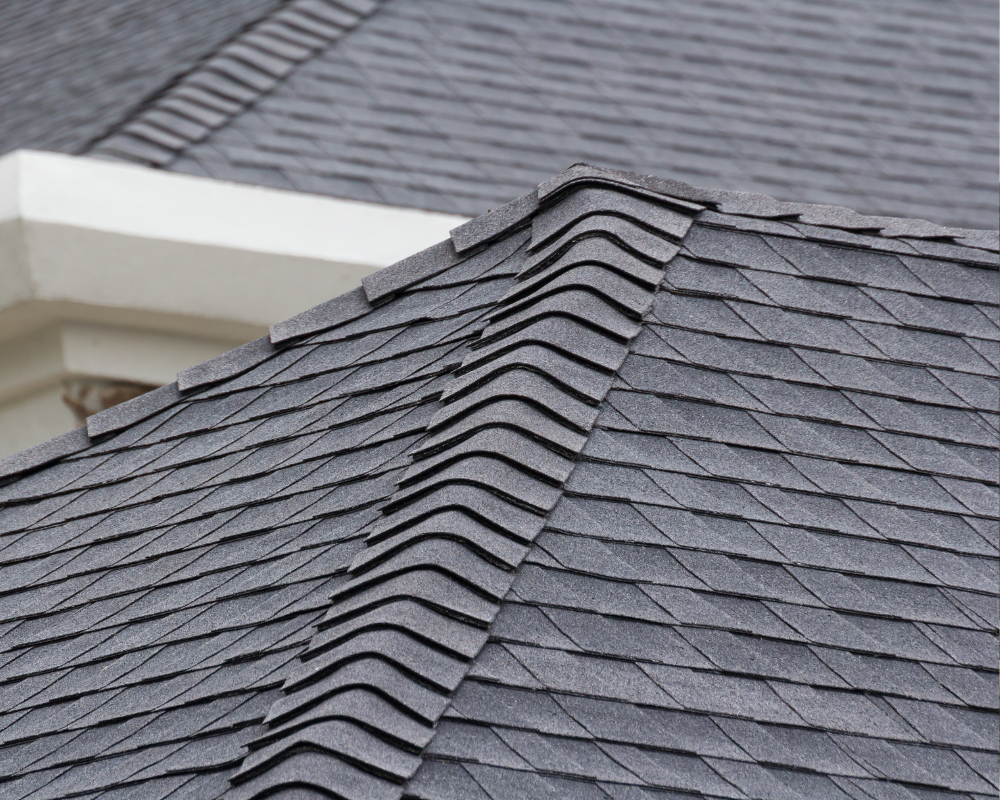
The choice of roofing material has a significant impact on the overall cost of your roof replacement. Asphalt shingles are the most common and affordable option, with a typical cost range between $3 and $5 per square foot. However, more durable materials like metal or tile roofs can cost upwards of $7 to $10 per square foot. The higher cost of these materials is often due to their durability and longevity, as well as the installation complexity. Homeowners can work with their roofing contractor to select materials that meet their budget while balancing durability and aesthetic preferences.
2. Labor Costs
Labor is one of the largest components of roof replacement costs. The average labor cost ranges from $3 to $6 per square foot, depending on the complexity of the roof, the type of material used, and the experience of the roofing crew. For larger roofs or more intricate designs, labor costs can add significantly to the overall price. To manage labor costs, homeowners should consider getting multiple quotes from reputable contractors and ensure that their project is well planned, reducing unexpected labor time.
3. Roof Size and Square Footage
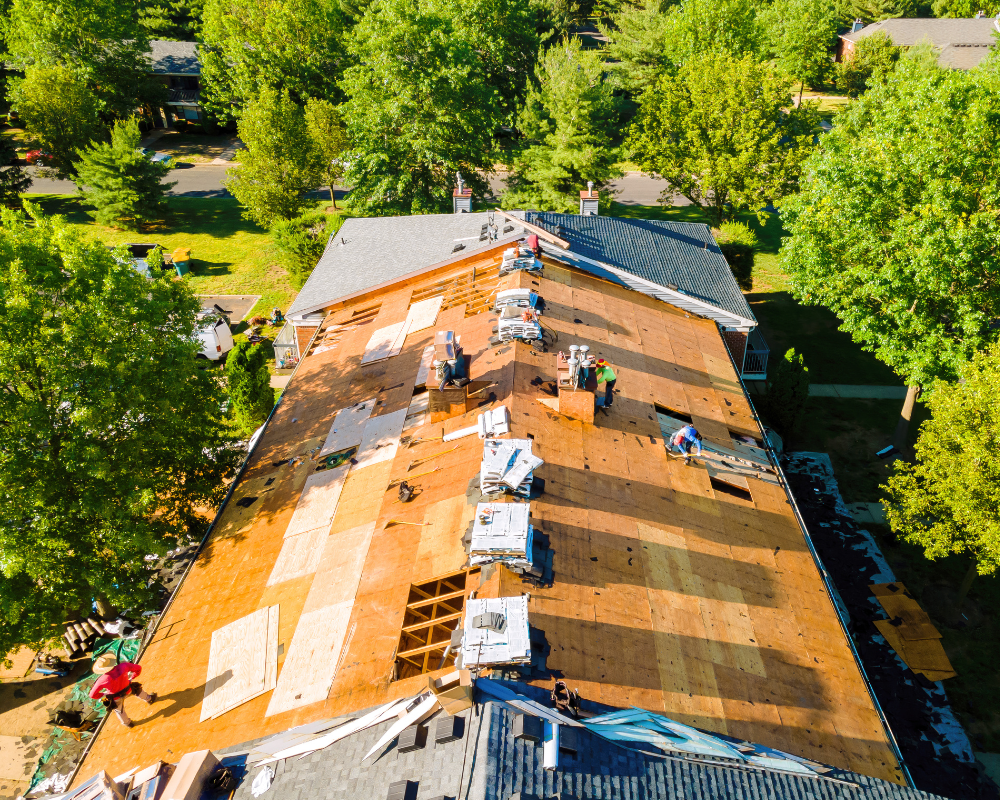
The size of your roof plays a crucial role in determining the total cost of the replacement. Larger roofs require more materials and more time to install, driving up the price. For example, replacing a 2,000-square-foot roof could cost anywhere from $5,000 to $12,000, depending on the materials and labor involved. Homeowners can manage costs by opting for roofing materials that are easier and quicker to install, and ensuring the roof design is straightforward to avoid unnecessary complications.
4. Tariffs and Material Price Fluctuations
Tariffs and supply chain disruptions have caused fluctuations in roofing material prices in recent years. In some cases, a rise in tariffs for imported roofing materials can add to the overall cost of the project. Homeowners should be aware that material costs can change over time and work with their contractor to purchase materials when prices are lower or consider using more locally sourced materials to avoid the effects of tariffs.
5. Safety Inspections and Permits
Before beginning a roof replacement, safety inspections and permits are often required, especially for larger projects or those involving complex materials like metal or tile. These inspections ensure that the roof meets building codes and safety standards, and they can add to the overall project cost. Homeowners can help minimize these costs by ensuring all required inspections are completed early in the process and by working with a roofing contractor familiar with local building codes and permitting procedures.
6. Inclimate Weather and Delays
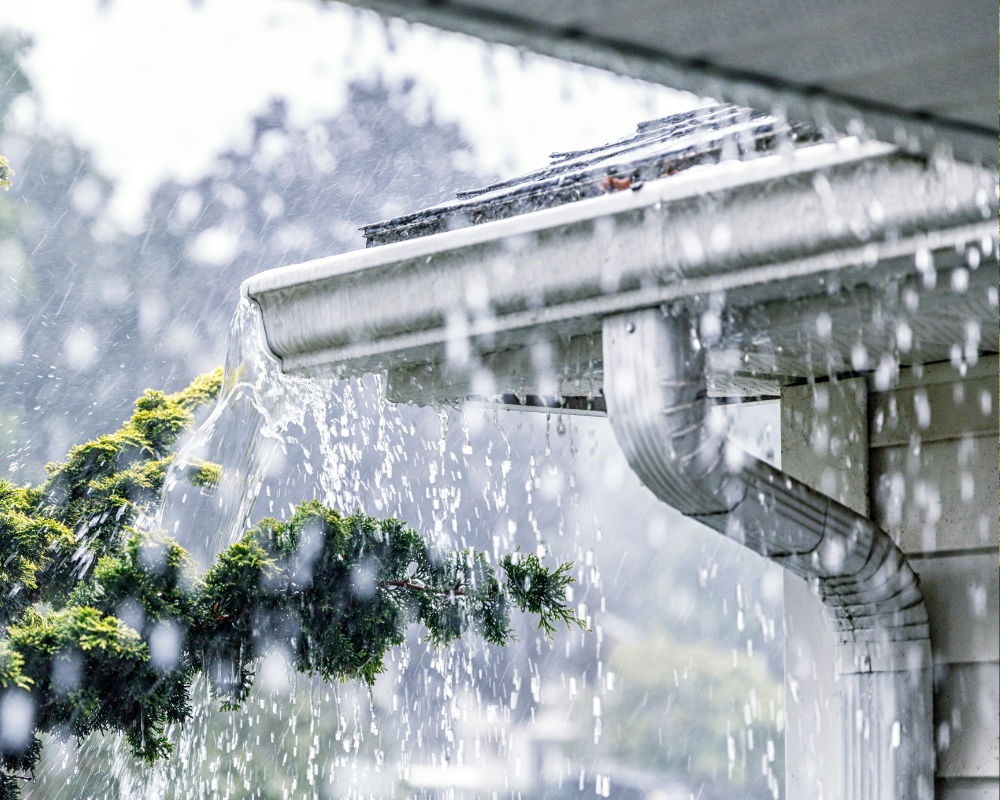
Weather conditions play a significant role in roofing projects, especially if there’s unexpected rain, snow, or high winds. Inclement weather can cause delays, prolonging the project timeline and increasing labor costs. Additionally, some roofing materials, such as asphalt shingles, cannot be installed during extreme temperatures. To manage weather-related delays, homeowners should discuss project timelines with their contractor and build in some flexibility to avoid rushing the job during unpredictable weather conditions.
7. Clean-Up and Disposal Costs
Once the roof replacement is complete, there’s still the matter of cleaning up the debris and disposing of the old roofing materials. This process can add a few hundred dollars to the total cost of the project, depending on the size of the roof and the complexity of the removal. Homeowners can minimize these costs by ensuring that their roofing contractor includes cleanup as part of the project quote, or by discussing ways to reduce waste during the installation process.
Understanding the various factors that contribute to the cost of roof replacement will help homeowners make informed decisions and avoid surprises during the project. Roofing materials, labor, roof size, tariffs, safety inspections, weather delays, and clean-up all play a role in determining the final price of a new roof. By working closely with a reputable roofing contractor, homeowners can ensure that they’re getting the best value for their investment, keeping costs manageable while ensuring a quality roofing project.
Top 5 Red Flags That Scream You’re Dealing With a Bad Roofing Contractor
Choosing the right roofing contractor is crucial for ensuring that your home’s roof is in good hands. Unfortunately, not all roofing contractors have your best interests at heart. Knowing what to look for can save you from costly mistakes and dangerous situations. In this blog, we’ll highlight the top 5 red flags that scream you’re dealing with a bad roofing contractor. By recognizing these warning signs, homeowners can avoid hiring a contractor who will cause more harm than good.
1. No Written Contract or Agreement

One of the biggest red flags when hiring a roofing contractor is if they refuse to sign a contract. A professional roofing company will always provide a written contract outlining the scope of the work, materials used, timeline, payment schedule, and warranty information. Without a contract, homeowners leave themselves vulnerable to misunderstandings or even fraud. A solid contract ensures both parties are on the same page and protects your interests. Always demand a written agreement and read it carefully before signing.
2. Unreasonably Low Estimates
While everyone loves a good deal, extremely low estimates for roof repair or replacement should raise immediate concerns. A bad roofing contractor may provide a quote that is significantly lower than others to secure the job, only to cut corners on materials or labor. This can lead to poor workmanship and increased long-term costs. The average homeowner can spot this red flag by comparing quotes from multiple reputable contractors. If the price seems too good to be true, it probably is.
3. Lack of Proper Licenses and Insurance
A reputable roofing contractor will always be properly licensed and insured. If a contractor claims to be licensed but cannot provide proof, that’s a clear warning sign that they may not be legitimate. Working with an unlicensed roofer can expose you to potential legal liabilities, and if something goes wrong, you could be left footing the bill. Always ask for proof of licensing and insurance before agreeing to any work. Your roofing contractor should have both workers’ compensation and liability insurance to protect you and their team.
4. Poor Communication and Unresponsiveness

Communication is key to any successful home improvement project, and a bad roofing contractor often lacks clear communication. If a contractor is hard to get in touch with, doesn’t respond to emails or phone calls promptly, or avoids discussing details of the job, these are significant red flags. Homeowners should feel comfortable asking questions and receiving timely responses. Poor communication can lead to misunderstandings, missed deadlines, and subpar results. If you feel like you’re being ignored or stonewalled, it’s time to find a new contractor.
5. No Physical Office or Established Reputation
A professional roofing contractor will have a physical office or at least a solid online presence with customer reviews and a portfolio of completed projects. Contractors who operate without a permanent business location or a history of reliable work are often fly-by-night operations looking to make a quick profit. They may not have the necessary experience or resources to handle your roof replacement or repair. Before hiring any roofing contractor, do your research, check their reputation online, and make sure they have a legitimate business address. Trustworthy contractors will be happy to provide references and examples of their past work.
By recognizing these top 5 red flags, homeowners can avoid hiring bad roofing contractors and ensure that their roof replacement or repair is done correctly. A reputable roofing contractor will provide quality service, communicate effectively, and always prioritize your home’s safety and needs. Protect your home and investment by choosing a contractor who meets all the right criteria.
Why Energy-Efficient Window Replacement Pays Off Year-Round
When it comes to home upgrades that truly make a difference, replacing old, drafty windows with modern, energy-efficient ones stands out as one of the smartest investments a homeowner can make. At Empire Contractors, we know that window replacement isn’t just about looks—it’s about comfort, savings, and long-term performance. Whether you’re dealing with rising heating and cooling bills or simply looking to update your curb appeal, new windows can deliver value in every season.
The Real Cost of Inefficient Windows

If your home has aging or damaged windows, you’re likely paying more than necessary to maintain a comfortable indoor temperature. Drafts, condensation between panes, or cracked window glass can cause your HVAC system to work overtime. This not only raises your monthly utility costs but also shortens the lifespan of your heating and cooling equipment. Even minor issues that call for window repairs can add up over time if ignored.
Why Energy Efficiency Matters
Energy-efficient windows are engineered to reduce thermal transfer, which means they help keep warm air inside during winter and block heat during summer. This reduces the demand on your heating and cooling systems, helping you save energy and money.
High-performance windows typically include features such as:
- Low-E (low emissivity) coatings that reflect infrared light and reduce UV damage
- Argon or krypton gas fills between panes for improved insulation
- Double or triple glazing to minimize heat transfer
- High-quality framing materials like vinyl, fiberglass, or composite for improved insulation
These upgrades create a powerful thermal barrier between your home’s interior and the outdoors, stabilizing your indoor climate and improving year-round comfort.
Choosing the Right Window Type
Not all windows are created equal, and selecting the right window type is critical to maximizing energy efficiency. Two of the most common styles are double hung windows and single hung windows.
- Double hung windows have two operable sashes, allowing both the top and bottom to open. This improves ventilation and makes cleaning easier—especially for multi-story homes.
- Single hung windows, in contrast, only allow the bottom sash to move. While generally more budget-friendly, they offer slightly less airflow and flexibility than double hung styles.
Regardless of the style, selecting ENERGY STAR® rated models ensures you’re investing in performance-tested, energy-efficient options.
Window Glass Technology: What to Look For
Advanced window glass is at the heart of energy savings. Multiple panes of glass with gas fills and specialized coatings work together to reduce heat loss and solar gain. Look for features such as:
- Double-pane or triple-pane glass for insulation
- Low-E coatings to block infrared and ultraviolet rays
- Gas fills like argon or krypton that slow thermal transfer better than air
Some window models also include laminated or tempered glass for added security, noise reduction, and storm protection.
Professional Window Installation Matters
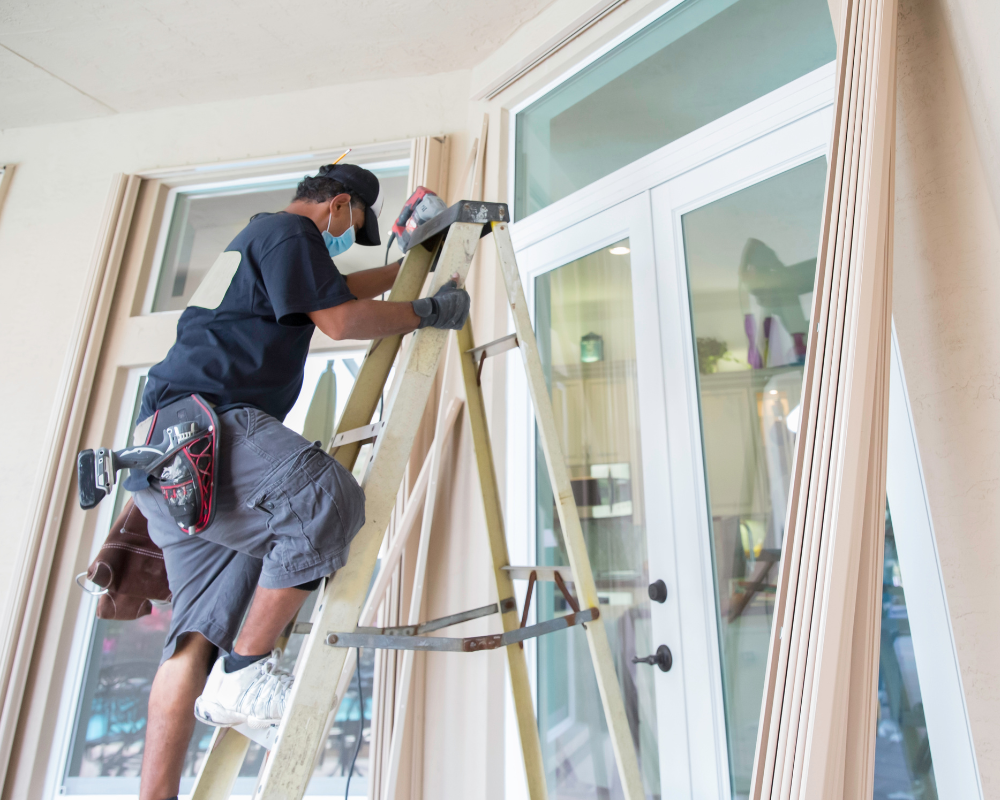
Even the best window on the market won’t perform properly without expert window installation. Gaps, poor sealing, or incorrect alignment can all undermine energy efficiency. At Empire Contractors, we ensure a perfect fit, airtight seals, and professional craftsmanship with every installation.
Proper installation helps prevent air leaks, water intrusion, and long-term structural damage—protecting your investment for years to come.
Long-Term Benefits: Comfort, Savings, and Value
Here’s how energy-efficient window replacement pays off:
1. Lower Energy Bills
By reducing thermal transfer, your home stays cooler in summer and warmer in winter, leading to measurable savings on utility bills.
2. Increased Home Value
According to industry studies, window replacement projects have one of the highest returns on investment among home improvements. Energy efficiency is a major selling point for today’s buyers.
3. Improved Indoor Comfort
No more drafts or hot spots—just consistent indoor temperatures, reduced noise, and UV protection for your furnishings.
4. Reduced Maintenance
Newer materials and technologies often mean less upkeep. Say goodbye to rotting wood frames or stuck sashes.
5. Eco-Friendly Performance
Energy-efficient windows help reduce your carbon footprint by lowering energy consumption.
When Is It Time for a Replacement?
You might need a full replacement if you notice:
- Persistent condensation or fog between panes
- Soft, rotting, or warped frames
- Drafts or uneven temperatures near windows
- Rising energy bills despite regular HVAC maintenance
- Difficulty opening, closing, or locking windows
If you’re unsure whether a full replacement or targeted window repairs are the better route, Empire Contractors offers professional consultations to help you decide.
Replacing your windows isn’t just about style—it’s about smart, year-round savings and improved living conditions. With expert installation, modern materials, and energy-efficient designs, today’s windows outperform those of decades past in every way.
At Empire Contractors, we specialize in high-quality window replacement, tailored to your home and your budget. Whether you’re replacing fogged window glass, switching from single hung windows to double hung windows, or just ready for a more energy-efficient home, we’re here to help.
Why Professional Rain Gutter Installation Matters for Long-Term Home Protection
Rain gutters may not be the most glamorous part of your home, but they’re one of the most crucial components when it comes to protecting your investment. A well-designed and properly installed gutter system defends your home against water damage, foundation issues, mold growth, and landscape erosion. While DIY solutions may seem tempting, professional rain gutter installation offers the long-term protection homeowners truly need.
The Role of Gutter Systems in Home Protection
Your home’s gutter system acts as the first line of defense against rainfall and storm runoff. When gutters are working correctly, they direct water away from your roof, siding, and foundation—areas that are vulnerable to costly damage. Without a proper gutter section layout and slope, rainwater can pool around your home, leading to:
- Foundation cracks and shifting
- Basement flooding
- Rotting fascia boards
- Mold and mildew problems
- Erosion of landscaping
Professionally installed gutters ensure the entire system is sloped correctly, securely fastened, and free of leaks—something that’s difficult to guarantee with DIY or improperly installed solutions.
Why DIY Gutter Installation Falls Short

Installing gutters may look simple, but as experts like This Old House and RoofScope point out, even small mistakes can compromise your home’s protection. Common DIY errors include:
- Incorrect slope or pitch, preventing water from flowing properly
- Weak attachment to fascia boards
- Poorly sealed joints and seams
- Using the wrong size gutters for your roof area
Professional installers evaluate your home’s unique roofline, climate needs, and drainage patterns to design a gutter system that works for the long haul.
The Benefits of Professional Rain Gutter Installation
Hiring a professional for rain gutter installation ensures that every gutter section is cut, sealed, and mounted with precision. Here’s what you can expect from a skilled contractor like Empire Contractors:
1. Expert Assessment and Customization
Professionals inspect your roof pitch, fascia integrity, and potential drainage issues before designing a system. They also select the right materials—aluminum, copper, or seamless options—to match both performance and curb appeal.
2. Proper Pitch and Alignment
Without the correct pitch (typically 1/4 inch for every 10 feet), water won’t flow properly and will pool or spill over. An experienced installer ensures the right angle throughout the system.
3. Secure Fastening and Sealing
Professionally installed gutters are mounted using sturdy fasteners and sealed joints, reducing the risk of sagging or leaking over time.
4. Efficient Downspout Placement
Professionals determine optimal downspout locations to prevent overflow and ensure even water distribution away from your home’s foundation.
5. Compliance with Local Codes
A licensed contractor ensures your gutter system meets local building codes and safety standards—something DIY installations often overlook.
Common Signs You Need New Gutters Installed
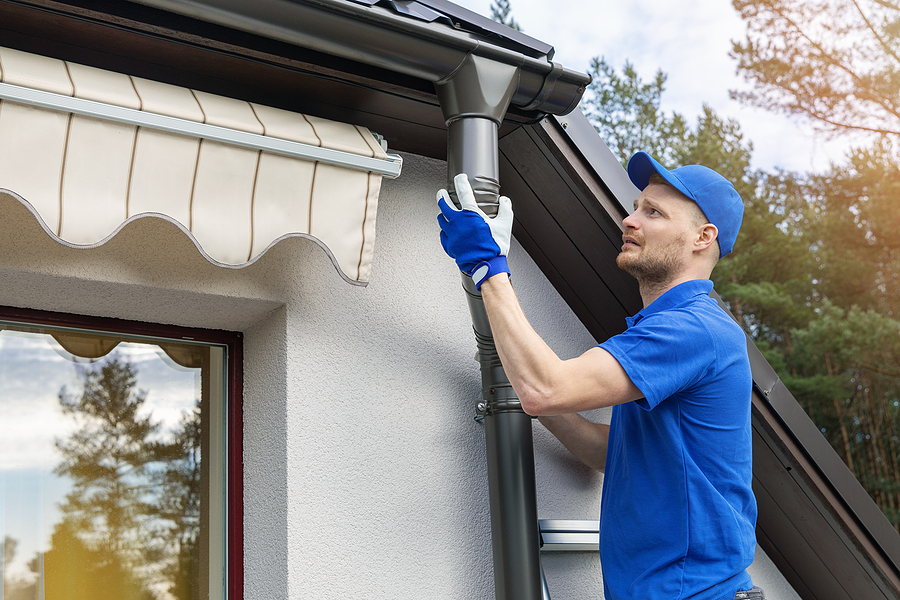
If you already have a gutter system in place but suspect it’s failing, watch for these signs:
- Water stains on your siding or fascia
- Pools of water near your foundation
- Sagging or detached gutters
- Rust, holes, or visible cracks
- Mold or mildew in your basement
In these cases, it’s often more cost-effective to have new gutters installed by a professional than to patch old ones that are beyond repair.
Choosing the Right Gutter System for Your Home
As noted by industry leaders like GutterTex and Rain Gutters Solution, not all gutter systems are created equal. Options like seamless gutters, gutter guards, and larger-diameter downspouts offer enhanced performance and lower maintenance.
Professionals can also advise you on upgrades such as:
- Leaf and debris protection
- Seamless aluminum or copper styles
- Hidden hanger systems for better aesthetics
- Oversized gutters for homes in high-rainfall areas
Rain gutters may seem like a small detail, but they play a major role in your home’s overall durability and value. Improperly installed gutters can lead to thousands of dollars in repairs, while a well-executed professional installation can last for decades with minimal upkeep.
At Empire Contractors, we specialize in custom gutter systems tailored to the needs of your home. Whether you need a brand-new system or are replacing failing gutters, our team ensures that every section is installed for maximum performance and protection.
The Real Cost of Delaying Roof Repair: What Homeowners Should Know
When it comes to your home, your roof is your first line of defense against the elements. But too often, minor issues like missing shingles or small leaks are ignored until they become big—and expensive—problems. At Empire Contractors, we’ve seen firsthand how delaying roof repairs can result in far more than just water stains on the ceiling.
Whether you have shingled roofing, metal roofing, or another type of roofing, postponing a fix can lead to serious structural and financial consequences. Here’s what homeowners should know about the real cost of putting off roof repair.
1. Minor Roof Damage Can Escalate Quickly
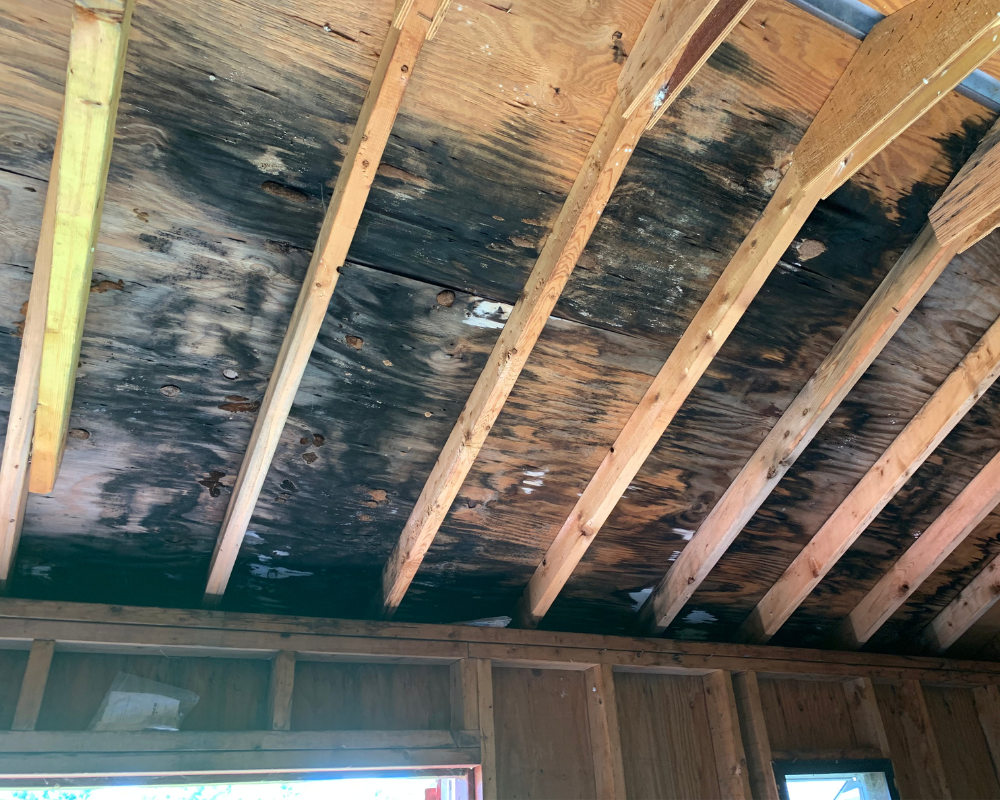
Roofing issues often start small: a few cracked asphalt shingles, a bit of granule loss, or a minor leak. But without prompt attention, that small damage can spiral into:
- Rotted decking
- Interior water damage
- Mold growth
- Insulation degradation
Not to mention the added cost of replacing damaged drywall, insulation, and possibly flooring. Addressing these problems early can prevent extensive (and expensive) restoration later on.
2. Hidden Signs of Damage Are Easy to Miss
Some of the most costly signs of damage aren’t obvious from the ground. For example, hail can bruise shingled roofing, weakening the protective granules even if the shingle looks intact. Similarly, storm damage can cause subtle cracks or uplift corners of shingles, leaving the roof vulnerable to wind-driven rain.
A professional inspection by a licensed roofing contractor can help catch these early indicators before they become severe.
3. Delays May Invalidate Your Insurance or Warranty
Waiting too long to repair your roof could jeopardize your homeowner’s insurance coverage. Most policies require timely action after a storm to qualify for storm damage claims. Similarly, manufacturers’ warranties on roof materials—like metal roofing or asphalt shingles—often specify that damage must be addressed quickly to remain valid.
Delaying a fix might leave you paying out-of-pocket for damage that would have been covered otherwise.
4. Energy Efficiency Takes a Hit
A damaged roof doesn’t just leak water—it leaks energy too. Missing insulation or broken seals allow air to escape, causing your HVAC system to work overtime. This leads to higher energy bills and a less comfortable home.
Replacing missing or broken roof materials promptly helps maintain your home’s energy efficiency—especially with highly reflective options like metal roofing.
5. Roof Replacement Becomes More Likely
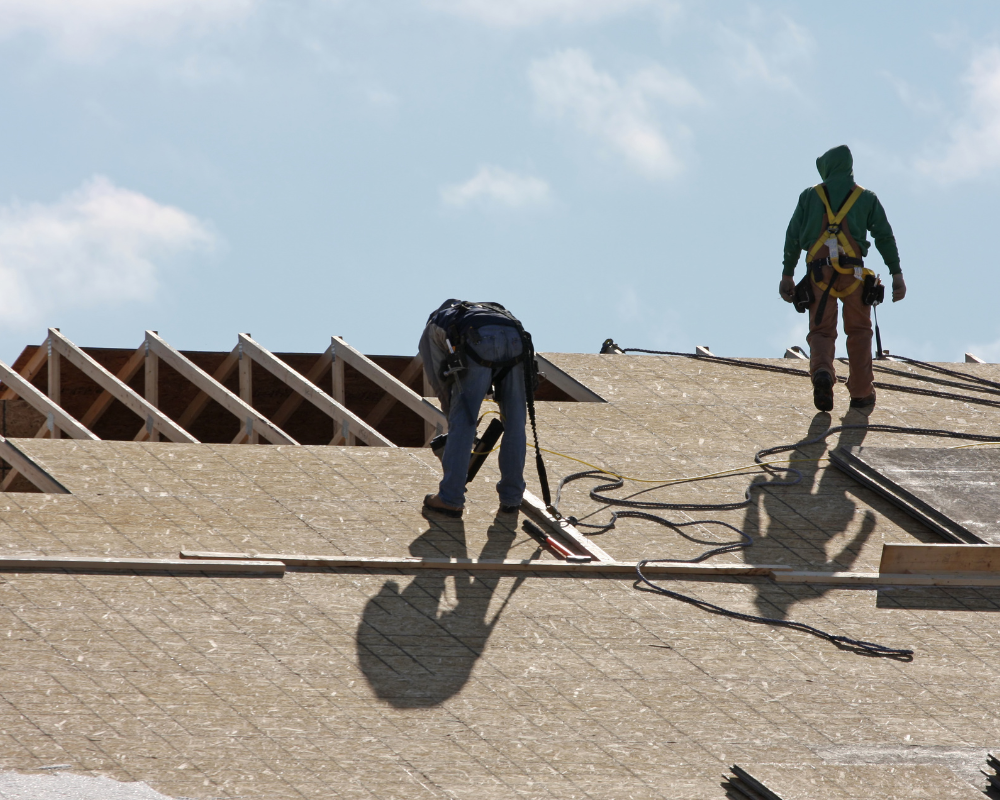
One of the biggest dangers of delaying repair is that you may end up needing a full roof replacement far sooner than expected. If the underlying structure is compromised by water or rot, replacing just the outer roof material won’t be enough. You’ll need to replace decking, underlayment, and sometimes structural framing.
Prompt attention to roof damage—especially after major storms—can significantly extend the life of your roof and save thousands in long-term costs.
6. Property Value and Curb Appeal Suffer
If you’re planning to sell your home, damaged or aging roofing is a red flag for buyers. Cracked asphalt shingles, rusting metal roofing, and visible water spots can reduce your home’s curb appeal and appraisal value. Potential buyers may demand concessions or walk away altogether.
A proactive repair shows that the home has been well-maintained—and could be the difference between a deal and a delay.
At Empire Contractors, we specialize in a wide range of roofing materials, from shingled roofing to metal roofing and more. Our team of experienced professionals is ready to inspect your roof, identify signs of damage, and provide honest recommendations—whether that’s a quick fix or a complete roof replacement.
Don’t wait for a small problem to become a major expense. Protect your investment, your comfort, and your peace of mind by addressing roofing concerns now.
Contact Empire Contractors today to schedule your roof inspection and take the first step toward
Choosing the Right Cincinnati Roofing Company: What Homeowners Should Know Before Replacing a Roof
When it’s time to replace your roof, finding the right Cincinnati roofing company can feel overwhelming. With so many companies in Cincinnati, Ohio offering residential and commercial roofing services, how do you know who to trust? Whether you’re dealing with an aging roof system, storm damage, or just want to improve your home’s curb appeal, choosing the right roof installers is one of the most important decisions you’ll make as a homeowner.
In this guide, we’ll walk you through everything you need to know to find the best roofing company in Cincinnati, including what sets top companies apart and what to look for before starting your roof replacement project.
Why Choosing the Right Roofing Contractor Matters
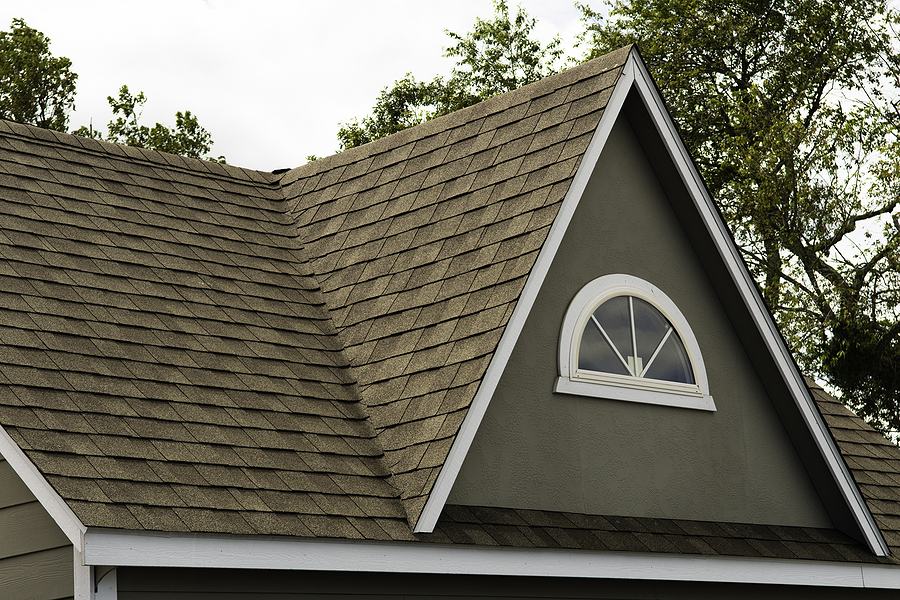
Your roof isn’t just shingles—it’s your home’s first line of defense against the elements. A professionally installed roof system protects your property, increases energy efficiency, and boosts overall curb appeal. That’s why choosing a highly recommended Cincinnati roofing contractor is key.
Experienced Cincinnati roofers will not only install a durable roof using quality materials, but also help you navigate the often-complicated insurance claim process after a storm. Top roofers also provide insight into the best roofing materials for your needs, whether you’re considering asphalt shingles, metal roofing, or energy-efficient systems.
What to Look for in a Roofing Company in Cincinnati
Here are the essential traits that separate the best roofing companies in Cincinnati, Ohio from the rest:
1. Local Experience and Reputation
Companies like Deer Park Roofing and Molloy Roofing have built a strong local presence by delivering consistent, reliable service. Look for roofing companies with a history in Cincinnati and a track record of success in both residential and commercial roofing.
2. Licensed, Insured, and Certified Roof Installers
Only hire roof installers who are fully licensed and insured. Bonus points if they hold certifications from top manufacturers—this ensures they follow best practices and can offer extended warranties on roofing materials.
3. Range of Roofing Services
The best companies offer a wide variety of roofing services, including:
· Full roof replacement
· Roof repair and inspection
· Gutter installation (such as seamless aluminum gutters)
· Skylight and ventilation upgrades
· Commercial roof systems for businesses
This breadth of services shows they can tailor solutions to your specific needs—whether you’re dealing with a leak on your existing roof or planning a complete overhaul.
4. Commitment to Customer Service
Outstanding customer service is a must. Companies like Feazel and Bone Dry Roofing stand out for their responsiveness, transparency, and ability to walk customers through every step of the process. From helping you file with your insurance company to conducting post-installation inspections, great service ensures peace of mind.
Questions to Ask Before Hiring a Cincinnati Roofing Contractor
Before signing a contract, ask potential contractors the following:
· Are you local and how long have you served the Cincinnati area?
· What roofing materials do you recommend and why?
· Do you have experience with both residential and commercial roofing?
· Can you provide a written estimate and warranty?
· What’s your process for working with an insurance company on storm damage claims?
Why Empire Contractors Stands Out Among Cincinnati Roofers

At Empire Contractors, we’re proud to be a highly recommended roofing company in Cincinnati known for delivering long-lasting results, superior workmanship, and excellent customer support.
Our experienced team installs quality materials designed for performance and curb appeal, whether you need a new commercial roof system or a full roof replacement for your home. We also install durable aluminum gutters to protect your roof and foundation from water damage.
With years of experience serving homeowners and businesses across Ohio, Empire Contractors is your trusted partner for roofing services done right the first time.
Finding the right Cincinnati roofing contractor requires more than a quick Google search. Look for professionalism, experience, and a reputation built on customer service and dependable results. Whether you’re replacing an existing roof, upgrading to better roofing materials, or improving your property’s curb appeal, Empire Contractors is here to help.
Contact us today to schedule your free estimate and see why we’re one of the top-rated roofing companies in Cincinnati, Ohio.
